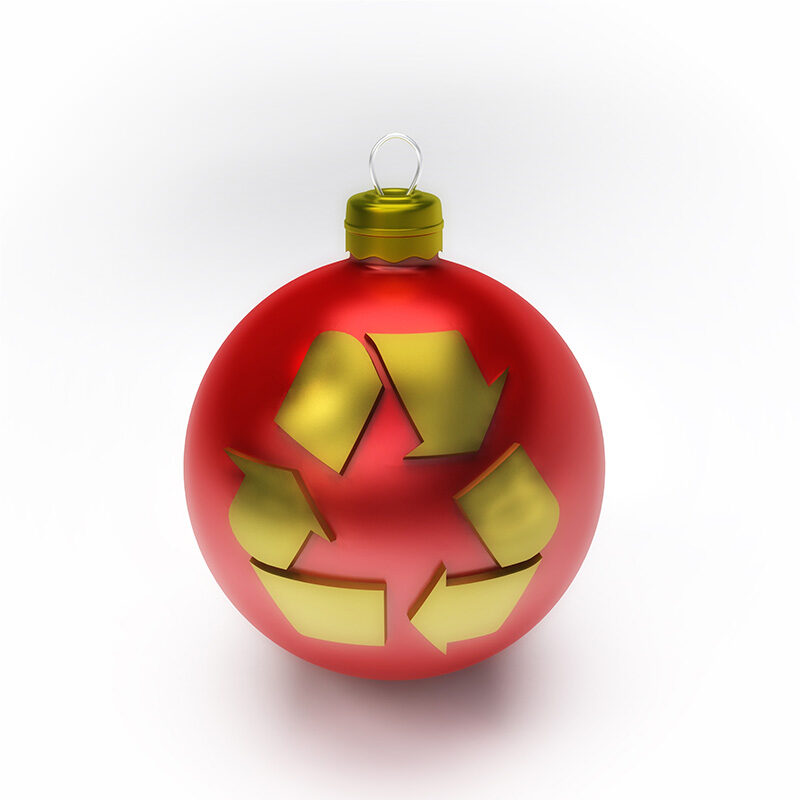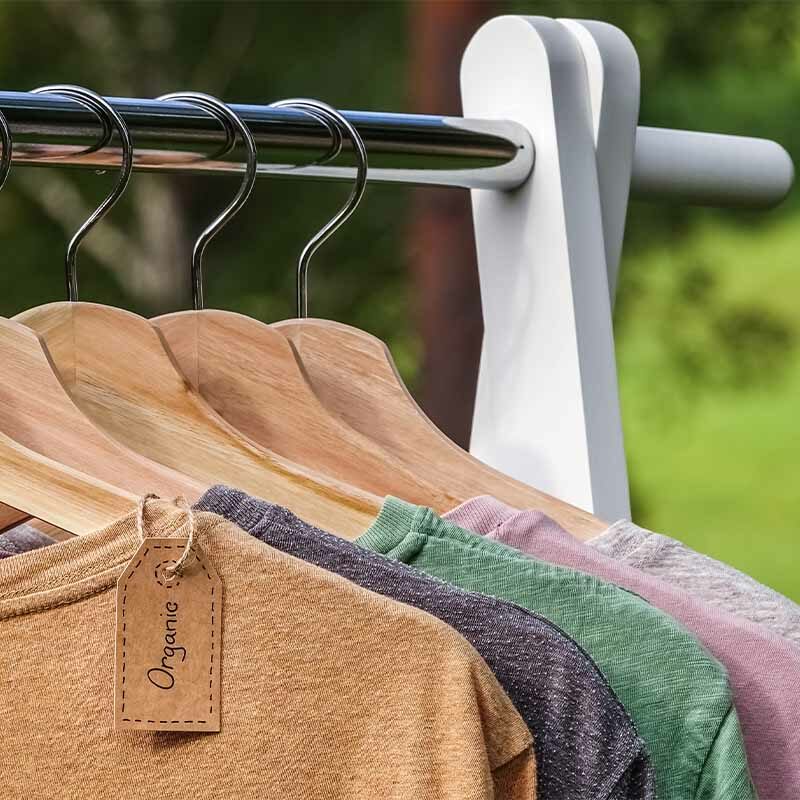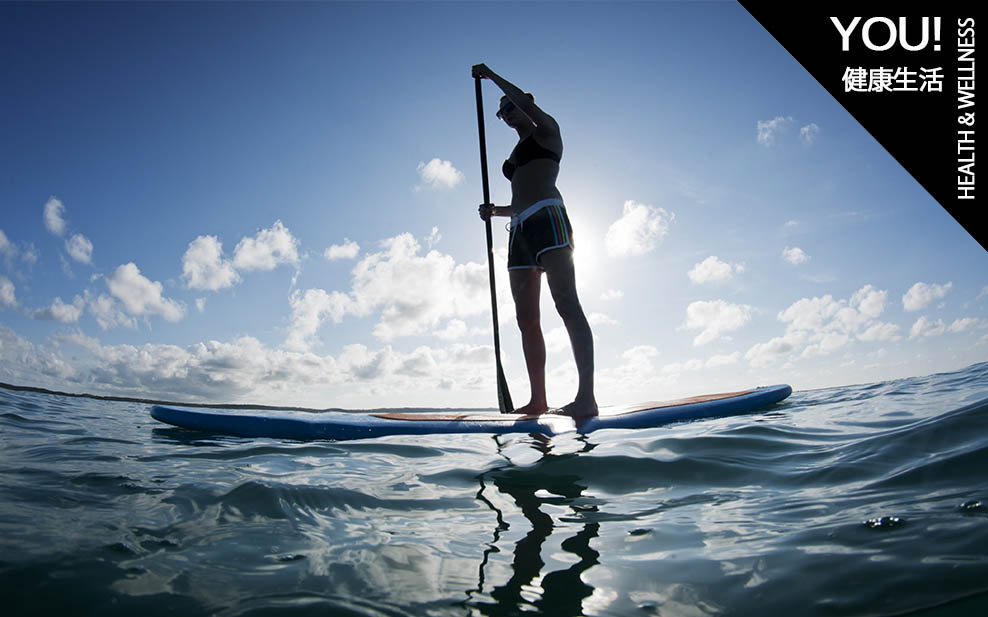
Stand-Up Paddle Boarding: 4 Reasons to Exercise in the Great Outdoors
Earth Month is upon us, and while we believe every month should be dedicated to caring for our Mother Earth, we’re excited to share one of our favourite outdoor activities to help you gain an appreciation for all that the Hong Kong outdoors have to offer! In our recent WELL, WHO? EXCLUSIVE with Andy Cornish we learned that “The primary use of Hong Kong waters is shifting from fishing to recreation.” This is great news for Hong Konger’s looking to help support the local economy while getting a good workout on the water.
Improve your health and fitness with Stand Up Paddle Boarding!
Why is Stand-Up Paddle Boarding (SUP) such an exceptionally effective and fun way to improve your health and fitness? Unlike many other sports, SUP is pretty accessible. You’ll need a large enough board and a paddle – although a buoyancy vest and a leg leash are recommended to keep you safe in the (relatively) warm seawater we are blessed with here in Hong Kong.
SUP can be an effective combination of physical exercise and mental detox, as you glide along, surrounded by nature. It’s a perfect antidote to the daily stresses that threaten to overwhelm even the most resilient multi-taskers in this hectic city.
1. You’ll Work Your Whole Body
SUP activates your core and leg muscles to provide a great workout, starting with the skills needed just to balance on the board. It contributes to your overall fitness levels and burns up calories fast. Sinking your paddle for long hard strokes involves your obliques and abdominals as you push the board forward through the water.
The American Council on Exercise (ACE) led two scientific studies on SUP, and concluded:
“SUP meets established industry guidelines for improving cardiorespiratory endurance and positively affecting body composition.”
“It’s a time when you can reconnect with your body and with the natural world.”
2. It’s Kind on Your Knees and Shins
Paddling on the water is generally a lot more forgiving on your joints than pounding the pavement. This means SUP is a fantastic way to cross train, whilst keeping your body safe from impact.
3. Your Sense of Balance Is Challenged
SUP is a great way to work on your balance. The water is constantly moving underneath you, so learning to stay on your board even on a gentle swell is an effective way to improve body awareness and coordination. This is benefit for other sports and for life in general.
4. A Natural Antidote to Stress
We can’t talk about SUP without mentioning the extra benefits of working out in the great outdoors. Paddling on the water, with the sky and sea stretching away for miles around is a perfect antidote to being cooped up in a tiny box in the city or sweating away in a crowded gym session. It’s a time when you can reconnect with your body and with the natural world.
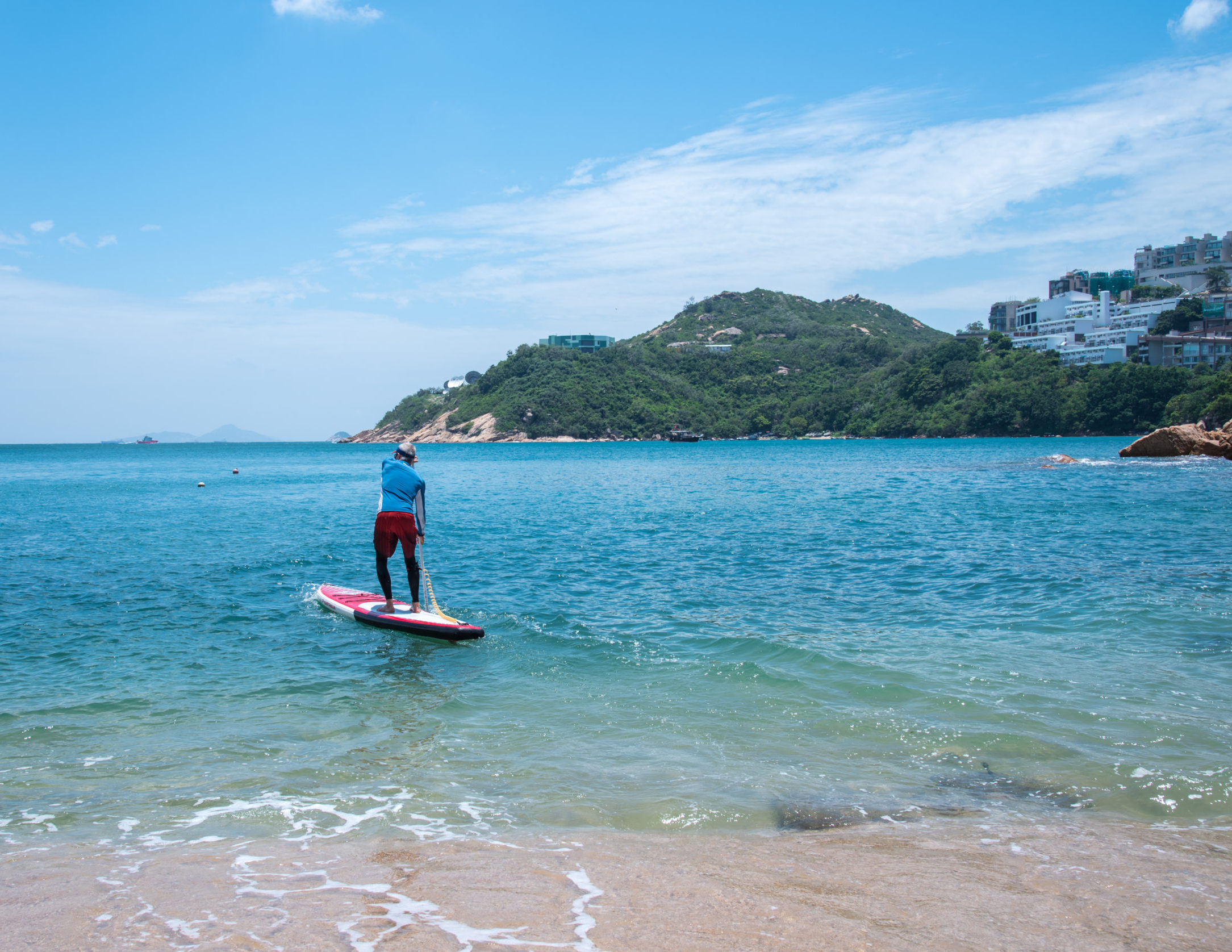
Getting Started
The best way to start SUP is with a qualified instructor who can take you through the basics to help you develop your confidence on the water.
Seek out instructors with credentials from established institutions like the Academy of Surfing Instructors (ASI). They will teach you proper paddling form to minimise chances of injury, and help you learn to identify and avoid potential hazards such as strong currents and submerged rocks.
If you are new to the sport, it’s recommended that you start on a beginner board. These boards are longer, wider and displace more volume than advanced and intermediate boards. This means they are more stable, and makes them a better platform to learn on, so less chance of ending up in the water!
It’s also recommended that you wear the appropriate safety equipment, such as a leg leash. This connects you to your board, so that if (when…) you fall into the water, your board is always nearby. This can make all the difference if you’re not the most confident swimmer or if you are far from land. Similarly, wear a buoyancy vest if you don’t feel 100% confident about open water swimming. Water shoes are also advisable if you are SUP-ing from a rocky shore. And sun protection is always advised, even on cloudy days.
Finally, take advice on the right sized paddle for your body shape and board type. As a simple guide, a paddle that stands 3 – 4 inches (7 – 10cm) above the top of your head is appropriate
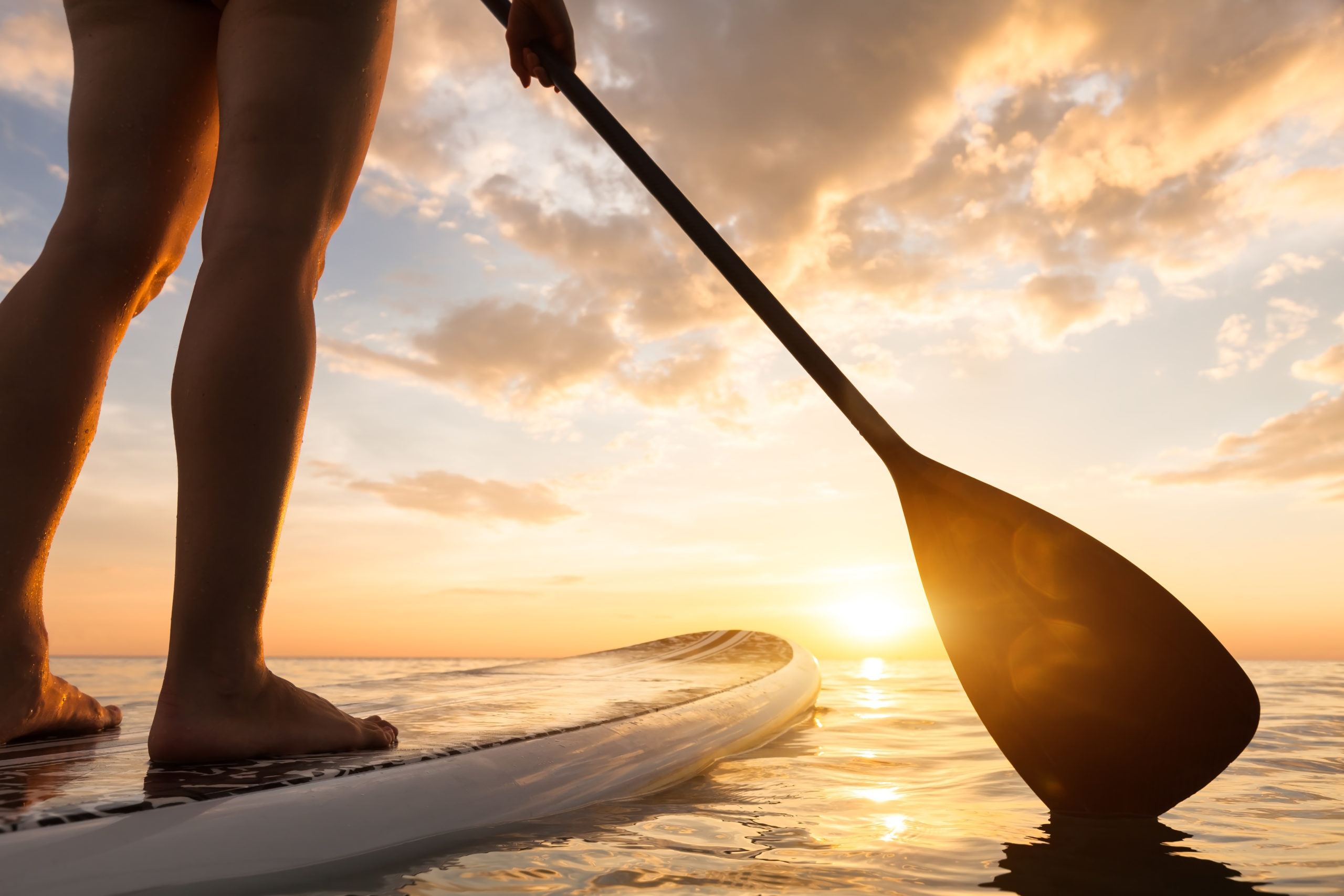
Learn About Local Weather Conditions
As a beginner it’s best to start in the calmest possible conditions, in terms of wind and swell. This makes it much easier to practice your technique and to go where you want to go, without stressing about losing control and falling into the water.
Both the Hong Kong Observatory, and Windy have great forecasting apps that can be used for watersports. A good SUP instructor will guide you on how to interpret the conditions and find the best times and locations to practice.
Getting On the Board
This sequence will get you on the board and away from the shore safely:
- Walk out into shallow water with the board and place it in the water
- Make sure the fin(s) at the back of the board isn’t touching the sand
- Orient the board in the direction of the oncoming swell
- Place your paddle onto the board, with the blade on the board and the shaft pointing up and out over the nose (like a rhino’s horn)
- Slide onto the board and paddle away from the shore
- If you want to paddle to the left, then take a few hard strokes with your right hand to turn the board. And if you want to paddle to the right, take a few hard strokes with your left hand
Getting On Your Knees
This is a great way of getting about on a board if you are a beginner. You have a lower centre of gravity, so you are far more stable and it’s easier to get the board going in the direction you want it to.
To paddle on your knees:
- Kneel in the centre of the board, midway between the nose and tail. Keep your knees shoulder width apart
- Grip the bottom half of the paddle with your arms shoulder width apart. Your lower arm should be on the shaft just above the blade, and your upper arm roughly halfway up the shaft
- Rotate the side of the body the paddle is on to allow you to extend the blade forward towards the nose of the board
- Insert the paddle in the water
- Bring the board past the paddle by rotating your core back to neutral
- Recover by bringing the blade up and out of the water and ready for the next catch
To turn, sweep the paddle in a wide arc from the nose of the board to the tail of the board. We call this ‘the rainbow’. To turn left, make the arc on the right side of the board, and to turn right, make the arc on the left side.
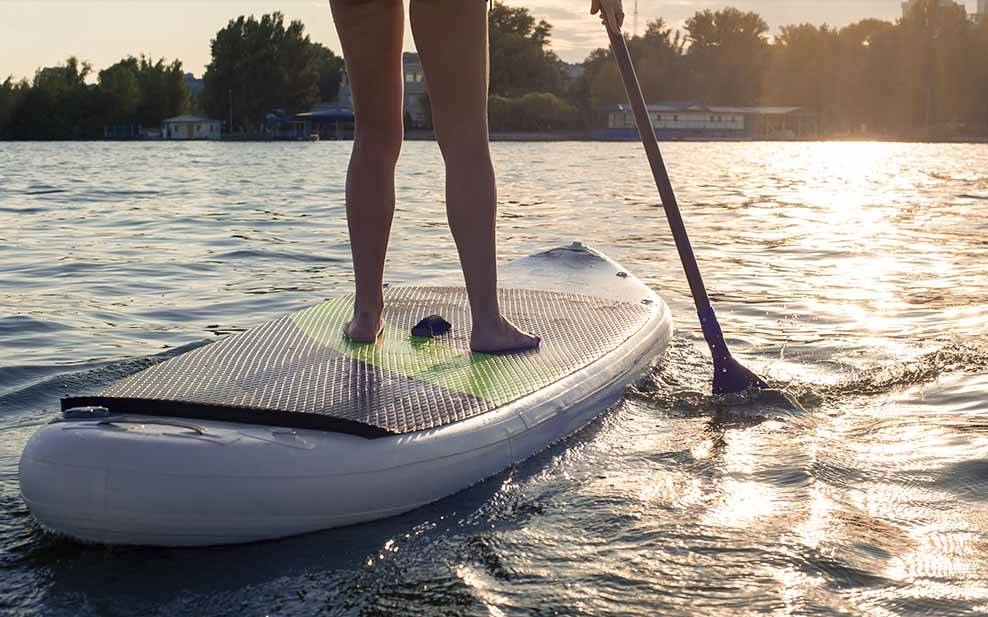
Getting Up For the First Time
Once you are happy on your knees, you can progress to standing.
- Move from a kneeling position into a tabletop position. Your hands should be on the board, with the paddle underneath your hands and perpendicular to the board. Your back should be flat. You can tuck your toes in to give you a bit of leverage for the next step
- Walk one leg at a time forward into the centre of the board, until you can get into a squatting position with your feet shoulder width apart
- Stand slowly while looking at the horizon to improve your balance
- Keep your knees relaxed to absorb the movement of the water and to stay upright
- Hold the paddle further up the shaft. Your upper hand should be on the handle, and your lower hand a shoulder’s width down the paddle shaft
- Paddle and turn using the same technique as on your knees
If you lose your balance, always try to fall away from the board, as falling into the water hurts less than falling onto your board. To get back on, if you fall in, swim to the side of the board, grab the side of the board opposite you and pull your torso onto the centre of the board, before swinging your legs up. Alternatively, swim to the tail of the board and inchworm your way up from there.
With some perseverance, SUP can become a vital tool in your mental and physical fitness toolkit. It’s a metaphor for the daily battles of being knocked down or pushed off course and making yourself get right back up and do it all over again: So, get paddling!
Esther runs Island Paddle – a specialist facility for pre-natal, post-natal fitness and yoga in with her partner, Niall in Stanley, Hong Kong.
Written exclusively for WELL, Magazine Asia by Esther Bland
Thank you for reading this article from WELL, Magazine Asia. #LifeUnfiltered.
Connect with us on social for daily news, competitions, and more.


